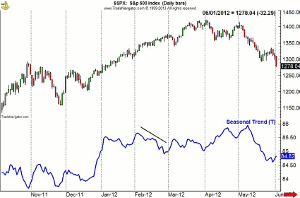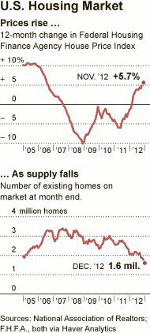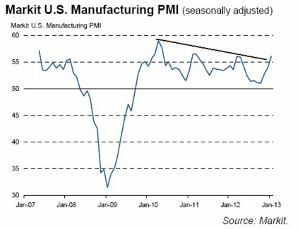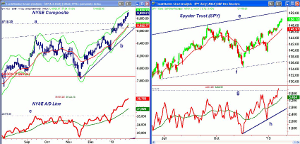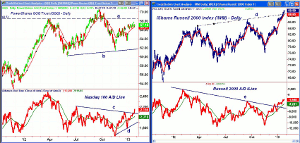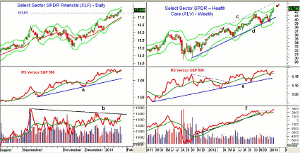According to recent Bloomberg survey, investors are the most bullish on stocks in at least 3-1/2 years, and the powerful stock market rally certainly reflects that, but MoneyShow's Tom Aspray counsels that it's exactly during times like these that caution is warranted more than ever.
The stock market continued to push higher again last week as more market skeptics gave up on their bearish stance. With the Dow Industrials and S&P 500 now back to levels last seen over five years ago, it is becoming harder for many to remain on the sidelines. With Friday's positive close the S&P 500 ended higher for eight up days in a row, which has not happened since 2004.
The market has been very resilient over the past few weeks as any early selling was well supported, and by the end of the day, the major averages were back into positive territory. While this is very encouraging for those who are long, it is quite frustrating for those who are belatedly trying to get into the market.
The startling performance of stocks like Netflix, Inc. (NFLX), which is up 50% this week also can encourage some to jump ion at the wrong time. As I noted earlier this month, it was the least liked stock by Wall Street and as I posted on January 20, the weekly technical studies were strong. As Carl Ischan explained in a recent interview, he bought NFLX mainly because everyone else hated it.
The new all-time highs in the Dow Transportation Average has fueled further buying as some expect the Dow Industrials and S&P 500 will also soon make new all-time highs. Does this mean you should be buying the market now?
This is the type of market that encourages some investors to follow their emotions, which is never a good idea. Let's look at some reasons why you may want to be more cautious over the next few weeks.
The 5% gain in Spyder Trust (SPY) so far in the month, and the fact that we have not had one close below the prior day's low all months increase the odds of at least a 1-2 day pullback. Also while stocks often do well in January, February is often a different story
The daily seasonal chart of the S&P 500 that analyzes data going back to 1930 reveals that typically stocks peak in early January, decline until January 24 before rallying until February 2. This has not been the case so far this year. Typically an early February high sets the stage for a decline that lasts for most of the month. This sets the stage for stocks to move higher into May.
For the last three years, prices have been higher in February with gains of 4.06% in 2012, 2.95% in 2011, and 2.85% in 2010. Looking back over the past 40 years, February was one of the two months that showed a loss, but it was considerably better than September, which was the worst month.
Now, some stock market strategists are already raising their yearly upside targets for the S&P 500. If you remember last spring this also happened before the market corrected.
Of course the seasonal tendencies need to be paired with the technical outlook, which is still positive for the short term, as well as the long term.
Even though we do not have sell signals for the major market averages, there are signs some of the top sectors have lost some of their upside momentum.
|pagebreak|Therefore, there are quite a few reasons to expect a 3-5% correction in the next four-six weeks. Still there will be stocks to buy if you concentrate on the entry level and risk as not all stocks will correct as sharply as the overall market. I do think that it is a good idea also to take some nice profits if you have them.
The economic news last week was generally quite good and supported my view from last October that the strength in the stock market was a sign that the economy was really better than expected. Last fall, there were quite a few analysts who thought that we were already in another recession.
The outlook for the housing market continues to improve as while existing home sales were down a bit it was likely because of a lack of supply. These charts from the New York Times show the strong uptrend in prices and the downtrend in the number of existing homes on the market.
This is a bullish combination that has important implications for the economy as the housing market has played an important role in past recoveries. Rising home prices also impact the consumer who is likely to spend more. The New Home Sales data showed an unexpected drop last Friday, but November's data was revised higher and prices are still climbing.
The leading indicators also were up last week with the weak consumer sentiment the primary negative. More encouraging was the flash PMI report from Markit, which rose to 56.1, thus reflecting "strong improvement in manufacturing business conditions during January."
This week we have a full slate of economic reports starting on Monday with the Durable Goods Orders, Pending Home Sales, and the Dallas Fed Manufacturing Survey. On Tuesday, we get the S&P Case-Shiller Housing Price Index, along with Consumer Confidence.
Of course, this is the week for the monthly jobs report and Wednesday we may get an early read from the ADP Employment Report, which will be followed by the GDP and the announcement from the FOMC after their two-day meeting.
After Thursday's report on jobless claims, we get the personal income and outlays. Also out is the Chicago Purchasing Managers Index, which given the flash report should show improvement. Things don't slow down on Friday, as after the monthly jobs report, we get the PMI Manufacturing Index, Consumer Sentiment, the ISM Manufacturing Index, and Construction Spending.
|pagebreak|What to Watch
The postponement last week of the debt
ceiling debate removed one of the roadblocks to the stock market as the S&P
finally overcame the widely watched 1,500 level. The higher stock market and the
sharp decline in Apple's (AAPL)
stock price have dominated the news.
I have been looking for the S&P 500 to challenge the 1,500 to 1,520 level and the high last Friday was 1,503.27. The renewed interest in the stock market has caused a sharp increase in bullish sentiment of individual investors. According to AAII, the bullish% surged from 43.9% to 52.3% last week with the number of bears dropping to 24.27%.
One should know that the individual investor is not always wrong as I have found a high level of bearish sentiment to be more reliable that a high level of bullish sentiment. For example, the recent higher readings were 55.88% on January 6, 2011, and 63.28% on December 23, 2010. The S&P 500 had a low of 1,205.72 on December 20, 2010, and reached a high of 1,422 on April 2, 2011.
Last week the number of bullish and bearish financial newsletter writers was unchanged at 53.2% bullish and 22.3% bearish. In April 2011 the number of bullish hit 57.3%.
The attitude of the financial press and the individual investors has certainly changed from early January when I felt the market would be Scaling the Wall of Worry. Even though I am cautious about the market at current levels, there are still some stocks that look attractive at the right price.
Before they reported earnings last week, I recommended buying Microsoft Corp. (MSFT) if it dropped on a reaction to disappointing earnings. So far the buying level has not been hit but risking 5% to buy a stock close to year-long support that yields 3.1%, I think, puts the proper emphasis on entry level and risk. These are what I feel will be the key guidelines to follow in 2013.
In addition to searching for good risk buys, I will also continue to recommend taking profits on those positions that I feel are the most vulnerable to a correction.
The daily chart of the NYSE Composite shows the sharp move above the 2011 high of 8,718.25, which now becomes first support. The quarterly R1 level has been reached with the daily starc+ band now at 8938 and the weekly starc+ at 9040. It is still well below the all-time highs of 10,387 that was made in October 2007.
The NYSE Advance/Decline broke through resistance, line c, in December, which supported a bullish stance going into the start of the year. The A/D line continues to rise strongly and is well above its WMA.
There is first support now at 8,692-8,718 and then the uptrend in the 8,600 area. This is about 3.2% below the current price.
S&P 500
The Spyder Trust (SPY)
finally moved above the $150 level last week as it gained close to 1% for the
week. As I discussed before, the 100% or equality target is at $150.70 with the
quarterly R1 resistance at $150.58. The longer-term trend line resistance, line
e, is now at $152.40.
The S&P 500 Advance/Decline is rising sharply as it has moved above the highs from April 2012, line g. This is a bullish sign for the intermediate term. Its WMA is also now rising strongly.
There is first chart support now at $147.60-$148.60 with the rising 20-day EMA $146.97. This is about 2% below Friday's close. There is longer-term support and the quarterly pivot at $142.64.
|pagebreak|Dow Industrials
The SPDR Diamond Trust
(DIA)
moved well above the September high at $136.48 as it reached the 100% target and
the quarterly R1 resistance in the $138.80 area.
The next resistance is the trend line (not shown), which connects the May 2012 and September 2012 highs. Its is now just below $140. The weekly Starc+ band is at $140.31 this week.
The Dow Industrials A/D line (not shown) did make new bull market highs last week, which confirms the price action. The A/D line is now rising much more sharply.
There is support now at $136.74-$137.04, which was the gap from last week and then at $136.50, which was last fall's high. The rising 20-day EMA is now up to $135.06.
Nasdaq-100
The PowerShares QQQ Trust (QQQ)
looks ready to close the week pretty much unchanged as it spent most of last
week below the January 3 closing level at $67.20. Of course, this is because of
the heavy weighting in Apple Inc. (AAPL),
which still makes up over 13%.
The First Trust NASDAQ-100 Equal Weight Index (QQEW), which has an equal weighting of all 100 stocks in the Nasdaq 100 has moved above both the 2011 and the 2012 highs.
The QQQ is still below the strong resistance at $68.50 (line a), which corresponds to the highs from March 2012. There is additional resistance at the early October highs of $69.80.
The Nasdaq-100 A/D line is acting a bit stronger as it has moved well above its previous peak and has broken through the resistance, line c, that goes back to last summer.
The 20-day EMA is now at $66.66 with the quarterly pivot at $66.10. A close below $66 will weakened the short-term outlook and suggest a move to the additional support at $65.13, which was the closing level of 2012.
Russell 2000
The iShares Russell 2000
Index (IWM)
has continued to rally sharply as it looks ready to gain another 1.4% last week
just like it did the week before IWM has moved well above the former trend line
resistance (line d).
Both the equality target calculated from the November low to the December high and the quarterly R1 are in $90.45 to $90.60 area.
The Russell 2000 A/D line has moved well above the September highs, but is still well below the high from early 2012. It has stayed above its rising WMA and shows no signs yet of a top.
There is support for IWM now at $88.60, line d, and the rising 20-day EMA. Additional support in the $86.40-$87.20 area
|pagebreak|Sector Focus
The iShares Dow Jones
Transportation (IYT)
surged another 3% last week pushing the gain for the past two weeks close to 5%.
With the Dow Transports at new all-time highs, many are worried that the Dow
industrials have not yet made new highs.
I discussed this in detail last week as it is my opinion that this was not a problem for the near term. The Dow Industrial Average is now just about 2.2% below October 11, 2007 high of 14,198.
The Select Sector SPDR Energy (XLE) and Select Sector SPDR Consumer Discretionary (XLY) were two of the best performers again last week as they gained 1.7% and 2.1% respectively. I focused the seasonal tendency for crude oils to bottom in early February in my article Will This Be February's Hot Sector?. Though I was unable to buy the energy ETFs, there are several oil stocks in the portfolio.
The Select Sector SPDR Financial (XLF) was up 1.7% last week and the daily chart shows that the 161.8% Fibonacci target was exceeded with the daily starc+ band at $17.65.
The relative performance has not made new highs for the past few weeks, suggesting that the rally in XLF may be stalling. The OBV has just reached resistance at line b, but is still well below its September peak.
XLF fell short of my initial profit taking level at $17.56, but last Friday
before the close I tweeted to sell 1/3 of the position, which should have been
filled around $17.45.
The Select Sector SPDR Health Care (XLV)
gained another 1.4% last week as it reached the weekly starc+ band with its high
at $42.82. The upper trend line (line c) is now in the $44 area. Though the
longer-term charts still show significant upside potential, the risk on the long
side for the short term has increased with the impressive four-week rally.
The relative performance is above its WMA, but still below the highs from late 2012. A drop in the RS line below the previous low would be a short-term negative. The on-balance volume (OBV) did break out to new highs, overcoming resistance at line f. Our order to sell 1/3 at $42.78 was filled Friday.
The Select Sector SPDR Industrials (XLI) is also one of my favorite sectors and it was up 1.3% last week as were the Select Sector SPDR Utilities (XLU). The Select Sector SPDR Technology (XLK) was down slightly for the week.
Crude Oil
The March crude oil contract closed above $96
last week and the technical outlook continues to be strong. There is some
resistance in the $98 area with next major resistance at $100.
Precious Metals
The metals had a rough week and look like
they will continue to move lower this week as the technical action has turned
more negative.
The SPDR Gold Trust (GLD) gapped below its short-term uptrend, line a, last week suggesting that the recent lows at $158.39 will be tested, if not broken. The volume increased on the decline and the OBV has turned lower after testing its downtrend, line b. There is strong resistance now in the $162-$164 area.
The Global X Silver Mines ETF (SIL) has also dropped below it support in the $21.58 area, line c, which is a very negative development. It suggests that the recent trading range was just a continuation pattern or a pause in the overall downtrend. Volume picked up late last week and the OBV has also dropped to new lows.
The Week Ahead
As I mentioned last time, now that the
Spyder Trust (SPY)
has reached the $150 area, I have become more cautious on the stock market.
Though it is possible that stocks will accelerate to the upside this week, it is
more likely, in my opinion, that we will see some selling come into the market.
If we get a one-two day drop, it may be an early warning that the next rally
will fail so now is the time to pay attention and have your stops in place.
Though I will continue to look for new stocks to buy, I will also be looking more closely at the current positions. And, even though I expect stock prices to be higher than they are now in the coming months, the bullish camp is getting a bit too crowded.
Once we do get a correction, it should provide good entry levels for some of the market leaders that we did not get a chance to buy before Christmas. I will be updating the "Charts in Play" portfolio early next week.
Don't forget to read Tom's latest Trading Lesson, Tracking the Market's Trend.

